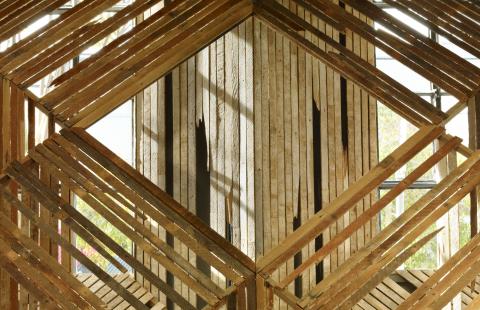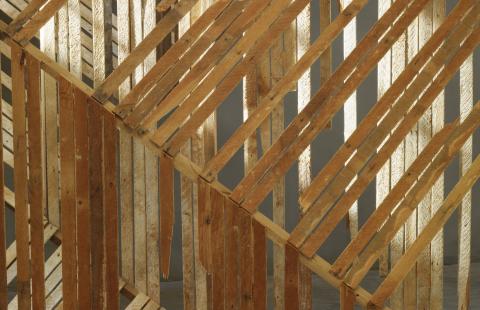Gray Area
San Francisco based artist Andy Vogt works with salvaged building materials to explore new architectural and sculptural forms. For his solo exhibition at Southern Exposure, Andy Vogt presents Gray Area, a large architectural intervention capturing a moment of light as it traverses the gallery windows and crosses from the exterior to the interior. Through this new sculptural installation, Vogt investigates the overlap between opposing perspectives and material consequences through a collision of light and space.
Essay by Kelsey Nicholson
“The line is a whole, an identity, for a particular place and time.”
Fred Sandback
For Andy Vogt, the idea of line manifests in the form of wood lathe. The strips are gutted from older homes, separated from its’ plaster binding and no longer holding a commercially viable purpose. The scrapped remains are tossed aside into the trash heap. Following an artistic tradition of making use of materials non grata, Vogt collects this refuse and considers the lathe as a pure material. By pure, the artist is referring to the notion that although we can recognize the material’s history, time and methodologies have rendered it useless. This exile from conventional to indeterminate worth is what frees Vogt to see only the line and tonality offered by what is now a simple piece of wood.
With his new large-scale installation at Southern Exposure, Vogt’s focus is to capture a moment of light as it traverses the windowpanes and makes contact with the interior. This light is captured and channeled within a built perspective, highlighting where rays converge and a new space is created. Two views are used to complete one vision. Examples of these presented dualities are; beams of light, wall and floor, bisecting lines, materials receding and protruding. Similar to the way that Fred Sandback could take a piece of string to intersect a space with an angled plane, Vogt’s simple techniques of alternating line direction and tonal shifts of the lathe creates depth and form. By constructing flat planes within space, Vogt undertakes composing three-dimensional isometric drawings.
A (zero) point of origin is where the three coordinates of height, width and length unite. In a room, this would be the corner. Vogt’s work begins at this node. However, for the undertaking of Vogt’s sculptures, the corner can take on the appearance of a ledge, wall, mountain, or monument. Vogt refers to GRAYAREA as an architectural intervention that creates corners within the structure from which we can visually turn to enter or exit the volumetric shafts of light.
There is an idea that involves explaining painting as what is put in and photography is as what is left out. This is a simple (or complex) equation of addition or subtraction. Vogt’s concentration on the establishment of light within the space also bring into focus what is outside of the frame: the sidewalk, buildings and streets receding in perspective, as well as the sky, sun, moon, and ultimately the universe in infinite expanse. All we are left with is a precise, yet fragmented representation of the unification of these points of reference. Vogt crops his sculptures with a similar thinking to a photographer’s eye while establishing a method of building that edits in constant reference to what we do not see. This is another example of Vogt’s ability to complete two divergent views into one cohesive assembly. Vogt has mastered a method of creating addition through the use of subtraction.



